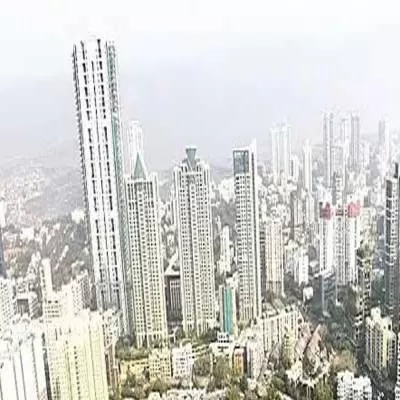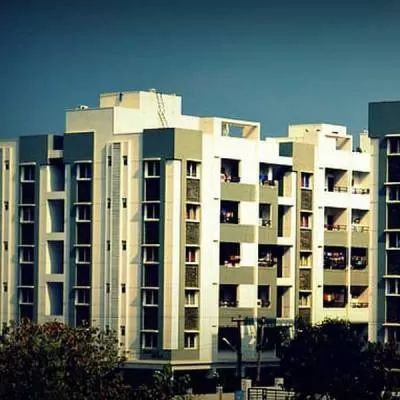- Home
- Real Estate
- Using Paper Waste Effectively

Using Paper Waste Effectively
Arecent study reveals that about 250-300 million tonne of industrial wastes are produced each year by chemical and agricultural processes in India. These can adversely affect the strength, durability and other properties of building materials based on them.
It is essential to dispose these wastes efficiently and safely without affecting the environment. Paper producing industries produce a large amount of solid waste; many companies burn their sludge in incinerators, which leads to air pollution. However, the problem of disposal can be solved by using paper waste. The added benefit: The use of paper waste can reduce the cost of construction material for a project. Recently, Dr Jayeshkumar R Pitroda, Assistant Professor-Civil Engineering Department, Birla Vishvakarma Mahavidyalaya Engineering College, submitted a research paper on this material, called ´hypo sludge´. He elaborates upon this material and its potential.
The current scenario
The Indian paper industry uses wood, agricultural residues and waste paper as raw materials. In the early 1970s, the share of waste paper used as raw material was only 7 per cent, whereas now it constitutes the major raw material base for the paper industry with 47 per cent share in total production being carried out by mills. Table 1 shows the amount of waste paper from wood and agro based mills.
What is hypo sludge?
Paper making generally produces a large amount of solid waste. Paper fibres can be recycled only a limited number of times before they become too short or weak to make high-quality paper. Broken, low-quality paper fibres are separated, to become waste sludge, which consumes a large percentage of local landfill space. Lime is used in the recycling process of paper. This along with the paper waste is called hypo sludge.
The problem of disposal
Hypo sludge consumes a large percentage of local landfill space. Worse yet, some wastes are spread on cropland as a disposal technique, raising concerns about trace contaminants building up in soil or running off into lakes and streams. Burning the sludge in incinerators contributes to air pollution. To reduce disposal and pollution problems emanating from these industrial wastes, it is most essential to develop profitable building materials from them.
Best from waste
To produce 1 tonne of ordinary Portland cement, manufacturers use resources like limestone; and in order to manufacture it, an equal amount of carbon dioxide is released into the atmosphere, which is harmful to the environment. Energy plays an important role for developing countries like India; using industrial waste (hypo sludge) for building materials such as cement can save energy while earning us carbon credits. This led to testing of innovative use of hypo sludge in concrete formulations as a supplementary cementitious material. Investigations were undertaken to produce low-cost concrete by blending various ratios of cement with hypo sludge.
Hypo-sludge concrete
About 300 kg of hypo sludge is produced from each tonne of recycled paper. This contains low calcium (CaO) and maximum calcium chloride (CaCl2) and a minimum amount of silica (SiO2). The shiny finish on glossy magazine-type paper is produced using a fine kaolin clay coating, which also becomes solid waste during recycling. As hypo sludge contains some cementitious properties, there are possibilities to replace the cement up to some percentage. So the concrete that contains hypo sludge as a replacing material is known as hypo sludge concrete. The chemical composition of hypo sludge (collected from the JK Paper Mill plant in Songadh, District Tapi, Gujarat) is given in Table 2.
Compressive strength test Compressive strength test on a 150 + 150 + 150 mm cube was done on a compaction testing machine. A table vibrator was used for compaction of hand-filled concrete cubes and cylinders. The specimens were de-moulded after 24 hours and subsequently immersed in water for different ages of testing. For each age, three specimens were tested for the determination of average compressive strength. The test was performed on a compression testing machine with a capacity of 200 mt. The results at seven, 14, 28, 56 and 90 days are presented in Table 3.
Advantages and disadvantages
As for its advantages, it provides an effective option to produce economical concrete, minimises environmental degradation owing to cement production (CO2 emission), and safeguards the ozone layer from greenhouse gases. It can be an easily adoptable option for partial replacement of cement while using paper industry waste usefully. It reduces the cost of construction for concrete members, promoting the development of low-cost housing for the economically weak. Further, it helps achieve design accreditations or certifications from the Indian Green Building Council (IGBC), Leadership in Energy & Environmental Design (LEED), The Energy and Resources Institute (TERI), Green Rating for Integrated Habitat Assessment (GRIHA), etc. And, as for its disadvantages, it contains a high amount of chlorine, which is difficult to handle. It is generally found in slurry form; hence, in order to mix it with cement, one has to remove water from it and make it dry. It is difficult to collect it in bulk quantity.
Cost
While this material has not been used in the commercial space as yet, it would cost a developer between 20-50 paise per kg, depending on transportation. The cost of concrete with various percentage replacement of cement by hypo sludge is computed for 1 cu m of concrete. As hypo sludge increases, the cost decreases. The results are given in Table 4.
In conclusion
Based on limited experimental investigations concerning the compressive strength test of concrete, the following observations can be made:
- For M40 grade of concrete, 20 per cent hypo sludge replacement with cement gives design strength at 28 days. (C6)
- The mixes reflect progressive gain in strength linearly from the age of seven to 90 days.
- The use of hypo sludge in concrete can save the paper industry disposal costs and produces a ´greener´ concrete.
- The cost analysis (Table 4) indicates that percentage cement reduction (20 per cent) decreases cost of concrete (-) 13.21 per cent, but at the same time strength also decreases.
- This research concludes that hypo sludge can be an innovative supplementary cementitious construction material, but judicious decisions must be taken by engineers.
TABLE 1: AMOUNT OF WASTE PAPER FROM WOOD AND AGRO BASED MILLS
| Year | Wood | % share agro residue | Waste paper |
|---|---|---|---|
| 1970 | 84 | 9 | 7 |
| 2000 | 39 | 31 | 30 |
| 2011 | 31 | 22 | 47 |
Source: Paper Industry
TABLE 2: CHEMICAL COMPOSITION OF HYPO SLUDGE
| Oxide | % age by weight |
|---|---|
| Silicon Dioxide (SiO2) | 5.28% |
| Calcium Oxide (CaO) | 47.84% |
| Magnesium Oxide (MgO) | 6.41% |
| Sulphur Trioxide (SO3) | 0.19% |
| Aluminium Oxide (Al2O3) | 0.09% |
| Ferric Oxide (Fe2O3) | 0.73% |
| Loss on Ignition | 38.26% |
Source: Geo Test House, Vadodara, Gujarat
TABLE 3: (AVERAGE COMPRESSIVE STRENGTH FOR CUBES (150 x 150 x 50 N/ sq mm) AT 7, 14, 28, 56 AND 90 DAYS FOR M40)
| Concrete Mix | % Replacement of Cement by Hypo Sludge | Average Compressive Strength (N/sq mm) | ||||
|---|---|---|---|---|---|---|
| 7 Days | 14 Days | 28 Days | 56 Days | 90 Days | ||
| A2 | 0 % | 34.81 | 45.04 | 50.81 | 52.89 | 53.93 |
| C5 | 10 % | 36.59 | 46.52 | 51.26 | 53.33 | 54.52 |
| C6 | 20 % | 34.22 | 39.11 | 40.74 | 42.81 | 43.26 |
| C7 | 30 % | 24.30 | 27.85 | 28.74 | 30.52 | 33.19 |
| C8 | 40 % | 20.36 | 23.26 | 24.00 | 25.19 | 26.52 |
TABLE 4: MATERIALS FOR DESIGNED FOR M40 CONCRETE
| Concrete Mix | % Reduction in cement by Hypo sludge | Designed Materials for Concrete | Total Cost [cu m] | % Change in Cost | ||||
|---|---|---|---|---|---|---|---|---|
| Cement [kg/cu m] |
Fine aggregate [kg/cu m] |
Coarse aggregate [kg/cu m] |
Grit [kg/cu m] |
Hypo sludge [kg/cu m] | ||||
| A2 | 0 % | 473.68 | 341.91 | 751.14 | 500.76 | - | 4,159.24 | 0 |
| C5 | 10 % | 426.31 | 341.91 | 851.58 | 567.72 | 47.37 | 3,884.50 | (-) 6.60 |
| C6 | 20 % | 378.94 | 341.91 | 851.58 | 567.72 | 94.74 | 3,609.75 | (-) 13.21 |
| C7 | 30 % | 331.58 | 341.91 | 851.58 | 567.72 | 142.10 | 3,335.06 | (-) 19.81 |
| C8 | 40 % | 284.21 | 341.91 | 851.58 | 567.72 | 189.47 | 3,060.32 | (-) 26.42 |
Containing cementitious properties, hypo sludge can be used to develop profitable building materials. Arecent study reveals that about 250-300 million tonne of industrial wastes are produced each year by chemical and agricultural processes in India. These can adversely affect the strength, durability and other properties of building materials based on them. It is essential to dispose these wastes efficiently and safely without affecting the environment. Paper producing industries produce a large amount of solid waste; many companies burn their sludge in incinerators, which leads to air pollution. However, the problem of disposal can be solved by using paper waste. The added benefit: The use of paper waste can reduce the cost of construction material for a project. Recently, Dr Jayeshkumar R Pitroda, Assistant Professor-Civil Engineering Department, Birla Vishvakarma Mahavidyalaya Engineering College, submitted a research paper on this material, called ´hypo sludge´. He elaborates upon this material and its potential. The current scenario The Indian paper industry uses wood, agricultural residues and waste paper as raw materials. In the early 1970s, the share of waste paper used as raw material was only 7 per cent, whereas now it constitutes the major raw material base for the paper industry with 47 per cent share in total production being carried out by mills. Table 1 shows the amount of waste paper from wood and agro based mills. What is hypo sludge? Paper making generally produces a large amount of solid waste. Paper fibres can be recycled only a limited number of times before they become too short or weak to make high-quality paper. Broken, low-quality paper fibres are separated, to become waste sludge, which consumes a large percentage of local landfill space. Lime is used in the recycling process of paper. This along with the paper waste is called hypo sludge. The problem of disposal Hypo sludge consumes a large percentage of local landfill space. Worse yet, some wastes are spread on cropland as a disposal technique, raising concerns about trace contaminants building up in soil or running off into lakes and streams. Burning the sludge in incinerators contributes to air pollution. To reduce disposal and pollution problems emanating from these industrial wastes, it is most essential to develop profitable building materials from them. Best from waste To produce 1 tonne of ordinary Portland cement, manufacturers use resources like limestone; and in order to manufacture it, an equal amount of carbon dioxide is released into the atmosphere, which is harmful to the environment. Energy plays an important role for developing countries like India; using industrial waste (hypo sludge) for building materials such as cement can save energy while earning us carbon credits. This led to testing of innovative use of hypo sludge in concrete formulations as a supplementary cementitious material. Investigations were undertaken to produce low-cost concrete by blending various ratios of cement with hypo sludge. Hypo-sludge concrete About 300 kg of hypo sludge is produced from each tonne of recycled paper. This contains low calcium (CaO) and maximum calcium chloride (CaCl2) and a minimum amount of silica (SiO2). The shiny finish on glossy magazine-type paper is produced using a fine kaolin clay coating, which also becomes solid waste during recycling. As hypo sludge contains some cementitious properties, there are possibilities to replace the cement up to some percentage. So the concrete that contains hypo sludge as a replacing material is known as hypo sludge concrete. The chemical composition of hypo sludge (collected from the JK Paper Mill plant in Songadh, District Tapi, Gujarat) is given in Table 2. Compressive strength test Compressive strength test on a 150 + 150 + 150 mm cube was done on a compaction testing machine. A table vibrator was used for compaction of hand-filled concrete cubes and cylinders. The specimens were de-moulded after 24 hours and subsequently immersed in water for different ages of testing. For each age, three specimens were tested for the determination of average compressive strength. The test was performed on a compression testing machine with a capacity of 200 mt. The results at seven, 14, 28, 56 and 90 days are presented in Table 3. Advantages and disadvantages As for its advantages, it provides an effective option to produce economical concrete, minimises environmental degradation owing to cement production (CO2 emission), and safeguards the ozone layer from greenhouse gases. It can be an easily adoptable option for partial replacement of cement while using paper industry waste usefully. It reduces the cost of construction for concrete members, promoting the development of low-cost housing for the economically weak. Further, it helps achieve design accreditations or certifications from the Indian Green Building Council (IGBC), Leadership in Energy & Environmental Design (LEED), The Energy and Resources Institute (TERI), Green Rating for Integrated Habitat Assessment (GRIHA), etc. And, as for its disadvantages, it contains a high amount of chlorine, which is difficult to handle. It is generally found in slurry form; hence, in order to mix it with cement, one has to remove water from it and make it dry. It is difficult to collect it in bulk quantity. Cost While this material has not been used in the commercial space as yet, it would cost a developer between 20-50 paise per kg, depending on transportation. The cost of concrete with various percentage replacement of cement by hypo sludge is computed for 1 cu m of concrete. As hypo sludge increases, the cost decreases. The results are given in Table 4. In conclusion Based on limited experimental investigations concerning the compressive strength test of concrete, the following observations can be made: For M40 grade of concrete, 20 per cent hypo sludge replacement with cement gives design strength at 28 days. (C6) The mixes reflect progressive gain in strength linearly from the age of seven to 90 days. The use of hypo sludge in concrete can save the paper industry disposal costs and produces a ´greener´ concrete. The cost analysis (Table 4) indicates that percentage cement reduction (20 per cent) decreases cost of concrete (-) 13.21 per cent, but at the same time strength also decreases. This research concludes that hypo sludge can be an innovative supplementary cementitious construction material, but judicious decisions must be taken by engineers. TABLE 1: AMOUNT OF WASTE PAPER FROM WOOD AND AGRO BASED MILLS .tg {border-collapse:collapse;border-spacing:0;} .tg td{font-family:Arial, sans-serif;font-size:14px;padding:10px 5px;border-style:solid;border-width:1px;overflow:hidden;word-break:normal;} .tg th{font-family:Arial, sans-serif;font-size:14px;font-weight:normal;padding:10px 5px;border-style:solid;border-width:1px;overflow:hidden;word-break:normal;} .tg .tg-yw4l{vertical-align:top} .tg .tg-baqh{text-align:center;vertical-align:top} .tg .tg-lqy6{text-align:right;vertical-align:top} Year Wood % share agro residue Waste paper 1970 84 9 7 2000 39 31 30 2011 31 22 47 Source: Paper Industry TABLE 2: CHEMICAL COMPOSITION OF HYPO SLUDGE .tg {border-collapse:collapse;border-spacing:0;} .tg td{font-family:Arial, sans-serif;font-size:14px;padding:10px 5px;border-style:solid;border-width:1px;overflow:hidden;word-break:normal;} .tg th{font-family:Arial, sans-serif;font-size:14px;font-weight:normal;padding:10px 5px;border-style:solid;border-width:1px;overflow:hidden;word-break:normal;} .tg .tg-baqh{text-align:center;vertical-align:top} .tg .tg-lqy6{text-align:right;vertical-align:top} Oxide % age by weight Silicon Dioxide (SiO2) 5.28% Calcium Oxide (CaO) 47.84% Magnesium Oxide (MgO) 6.41% Sulphur Trioxide (SO3) 0.19% Aluminium Oxide (Al2O3) 0.09% Ferric Oxide (Fe2O3) 0.73% Loss on Ignition 38.26% Source: Geo Test House, Vadodara, Gujarat TABLE 3: (AVERAGE COMPRESSIVE STRENGTH FOR CUBES (150 x 150 x 50 N/ sq mm) AT 7, 14, 28, 56 AND 90 DAYS FOR M40) .tg {border-collapse:collapse;border-spacing:0;} .tg td{font-family:Arial, sans-serif;font-size:14px;padding:10px 5px;border-style:solid;border-width:1px;overflow:hidden;word-break:normal;} .tg th{font-family:Arial, sans-serif;font-size:14px;font-weight:normal;padding:10px 5px;border-style:solid;border-width:1px;overflow:hidden;word-break:normal;} .tg .tg-yw4l{vertical-align:top} .tg .tg-baqh{text-align:center;vertical-align:top} .tg .tg-lqy6{text-align:right;vertical-align:top} Concrete Mix % Replacement of Cement by Hypo Sludge Average Compressive Strength (N/sq mm) 7 Days 14 Days 28 Days 56 Days 90 Days A2 0 % 34.81 45.04 50.81 52.89 53.93 C5 10 % 36.59 46.52 51.26 53.33 54.52 C6 20 % 34.22 39.11 40.74 42.81 43.26 C7 30 % 24.30 27.85 28.74 30.52 33.19 C8 40 % 20.36 23.26 24.00 25.19 26.52 TABLE 4: MATERIALS FOR DESIGNED FOR M40 CONCRETE .tg {border-collapse:collapse;border-spacing:0;} .tg td{font-family:Arial, sans-serif;font-size:14px;padding:10px 5px;border-style:solid;border-width:1px;overflow:hidden;word-break:normal;} .tg th{font-family:Arial, sans-serif;font-size:14px;font-weight:normal;padding:10px 5px;border-style:solid;border-width:1px;overflow:hidden;word-break:normal;} .tg .tg-baqh{text-align:center;vertical-align:top} .tg .tg-yw4l{vertical-align:top} .tg .tg-lqy6{text-align:right;vertical-align:top} Concrete Mix % Reduction in cement by Hypo sludge Designed Materials for Concrete Total Cost [cu m] % Change in Cost Cement [kg/cu m] Fine aggregate [kg/cu m] Coarse aggregate [kg/cu m] Grit [kg/cu m] Hypo sludge [kg/cu m] A2 0 % 473.68 341.91 751.14 500.76 - 4,159.24 0 C5 10 % 426.31 341.91 851.58 567.72 47.37 3,884.50 (-) 6.60 C6 20 % 378.94 341.91 851.58 567.72 94.74 3,609.75 (-) 13.21 C7 30 % 331.58 341.91 851.58 567.72 142.10 3,335.06 (-) 19.81 C8 40 % 284.21 341.91 851.58 567.72 189.47 3,060.32 (-) 26.42




















